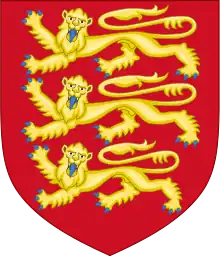Robert de Stratford | |
|---|---|
| Bishop of Chichester | |
 Tomb of Robert de Stratford in Chichester Cathedral | |
| Elected | between 23 July and 18 August 1337 |
| Term ended | 9 April1362 |
| Predecessor | John Langton |
| Successor | William Lenn |
| Orders | |
| Consecration | 30 November 1337 |
| Personal details | |
| Born | c. 1292 Warwickshire |
| Died | 9 April 1362 (aged 69-70) Aldingbourne, Sussex |
| Denomination | Catholic |

- a) a fess humette between three trestles, argent
- b) a fess humette or, between three trestles, argent[1]
Robert de Stratford (c. 1292 – 9 April 1362) was an English bishop and was one of Edward III's principal ministers.
Early life
Stratford was born into the landed Stratford family of Stratford-on-Avon around 1292. His father was another Robert and his mother was called Isabel. He was brother to John de Stratford (Archbishop of Canterbury) and possibly Henry de Stratford and Thomas de Stratford, Archdeacon of Gloucester (he was certainly a relation to both), to the latter of whom he gifted the manor of Shottery.[2] Robert senior has been identified as ‘Master’ Robert, co-founder and first master of the hospital of St Cross within the town, but in view of the title magister and the celibate status required, this appears unlikely. The family was related to the Hattons, important men in the town, Ralph Hatton ‘of Stratford’, the future bishop of London, being John's nephew. He was also a relative of Sir Andrew De Stratford.[3][4]
Career
Stratford served for a time as deputy to his brother John.[5] From 1329 he served as Prebend of Aylesbury[6] and then from 1331 to 1334 he served as Chancellor of the Exchequer and from March to July 1338 as Lord Chancellor.[7] He was dismissed as chancellor in 1338[7] but regained the office for six months in 1340.
From 1335 to 1338, Stratford was Chancellor of the University of Oxford.[8]
From 1334 to 1337, Stratford was Archdeacon of Canterbury.[9] He was elected Bishop of Chichester between 23 July and 18 August 1337, and was consecrated 30 November 1337.[10]
Death
Stratford made his will and died at his manor of Aldingbourne in Sussex on 9 April 1362.[11] Probate was granted on the 26th. His recumbent effigy lies in the south choir aisle of Chichester Cathedral.[4]
Citations
- ↑ Bedford, WK Riland. "The Blazon of Episcopacy" 1858
- ↑ 'The borough of Stratford-upon-Avon: Manors', A History of the County of Warwick: Volume 3: Barlichway hundred (1945), pp. 258-266. URL: http://www.british-history.ac.uk/report.aspx?compid=57019 Date accessed: 29 May 2014.
- ↑ Blomefield and Parkin An essay towards a topographical history of the county of Norfolk pp. 390
- 1 2 Roy Martin Haines, ‘Stratford, Robert (c.1292–1362)’, Oxford Dictionary of National Biography, Oxford University Press, 2004; online edn, Jan 2008 accessed 28 May 2014
- ↑ Haines, Roy (2004). "Stratford, Robert". Oxford Dictionary of National Biography (online ed.). Oxford University Press. doi:10.1093/ref:odnb/26648. Retrieved 7 December 2011. (Subscription or UK public library membership required.)
- ↑ Lipscomb, George (1847). The history and antiquities of the county of Buckingham (1847).
- 1 2 Fryde, et al. Handbook of British Chronology p. 86
- ↑ Hibbert, Christopher, ed. (1988). "Appendix 5: Chancellors of the University". The Encyclopaedia of Oxford. Macmillan. pp. 521–522. ISBN 0-333-39917-X.
- ↑ Wood, Anthony (1790). "Fasti Oxonienses". The History and Antiquities of the Colleges and Halls in the University of Oxford. pp. 22–23.
- ↑ Fryde, et al. Handbook of British Chronology, p. 239.
- ↑ Dalloway, James. "A History of the Western Division of the County of Sussex, Volume 1" 1815, p.53
References
- Haines, Roy. "Stratford, Robert". Oxford Dictionary of National Biography (online ed.). Oxford University Press. doi:10.1093/ref:odnb/26648. (Subscription or UK public library membership required.)
- Fryde, E. B.; Greenway, D. E.; Porter, S.; Roy, I. (1996). Handbook of British Chronology (Third revised ed.). Cambridge: Cambridge University Press. ISBN 0-521-56350-X.
